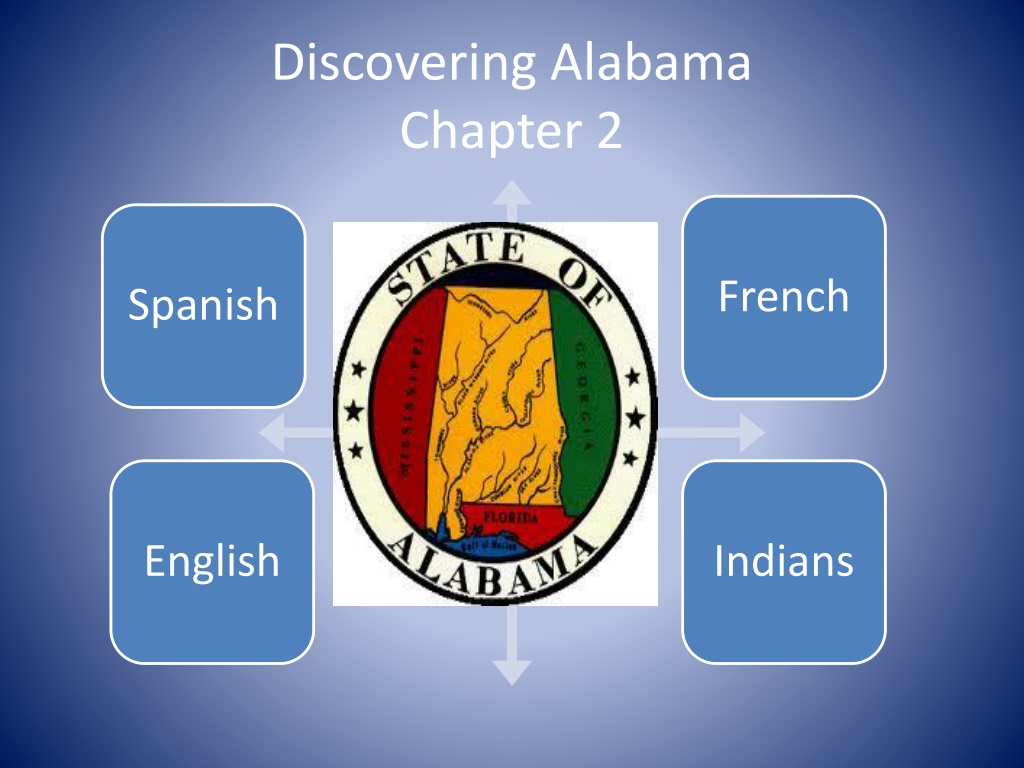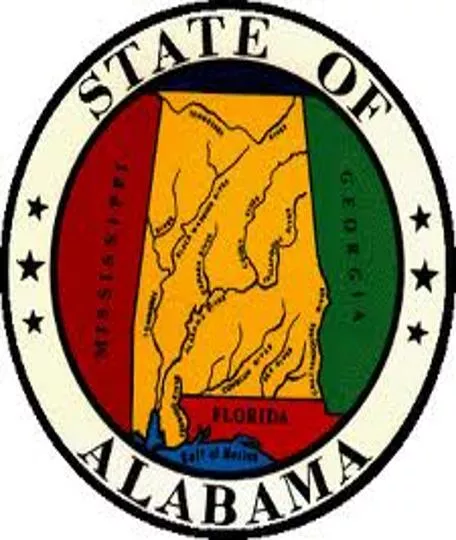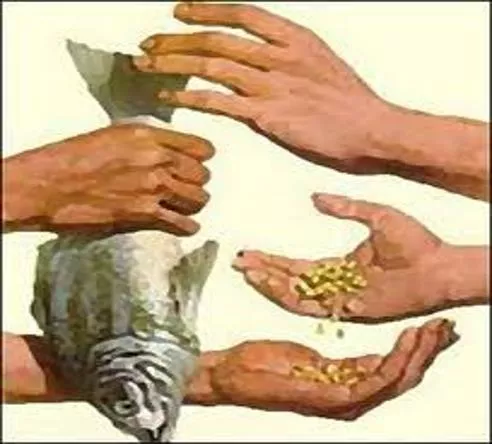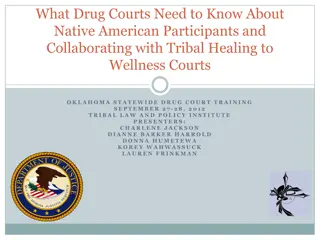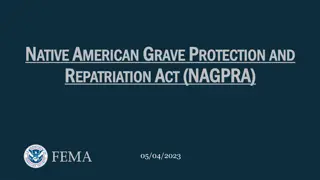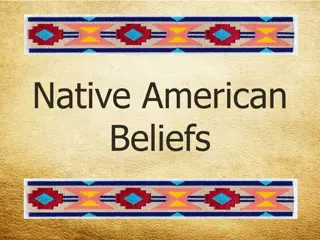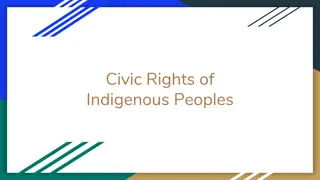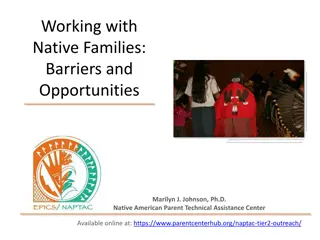Exploring Early Alabama: Europeans, Trade, and Native American Relations
In Chapter 2 of Discovering Alabama, the impact of French, Spanish, and English settlers on the Native American populations is explored. Key vocabulary such as immunity, bartered, cartographer, and more are highlighted. The lesson also delves into reasons for conflicts between Europeans and Native Americans in Alabama from 1519 to 1840, including differing beliefs on land ownership and cultural clashes. Students learn about the strategic positions, missions, and garrisons established during this period, along with the significance of oral traditions. Additionally, the lesson covers European exploration in Alabama, early settlements, and the transformations brought about by trade, health, land expansion, and tribal reorganization.
Download Presentation

Please find below an Image/Link to download the presentation.
The content on the website is provided AS IS for your information and personal use only. It may not be sold, licensed, or shared on other websites without obtaining consent from the author. Download presentation by click this link. If you encounter any issues during the download, it is possible that the publisher has removed the file from their server.
E N D
Presentation Transcript
Discovering Alabama Chapter 2 French Spanish English Indians
Discovering Alabama Chapter 2 Vocabulary Immunity Bartered Cartographer Palisade Strategic Position Mission Garrison Oral Traditions
Discovering Alabama Chapter 2 Vocabulary Immunity- resistance to disease
Discovering Alabama Chapter 2 Vocabulary Bartered- traded goods
Discovering Alabama Chapter 2 Vocabulary Cartographer- map maker
Discovering Alabama Chapter 2 Vocabulary Palisade- high wall around a town
Discovering Alabama Chapter 2 Vocabulary Strategic position- place useful for a strategy
Discovering Alabama Chapter 2 Vocabulary Mission- station or headquarters
Discovering Alabama Chapter 2 Vocabulary Garrison- place where soldiers are stationed for the purpose of defending it
Discovering Alabama Chapter 2 Vocabulary Oral traditions- cultural stories and tales
Discovering Alabama Lesson1 ALCOS 3. settlement in Alabama and the impact of Europeans on trade, health, land expansion, and tribal reorganization of Native American populations in Alabama. List reasons for European exploration and Locating European settlements in early Alabama Explaining reasons for conflicts between Europeans and Native Americans in Alabama from 1519 to 1840 Examples: differing beliefs regarding land ownership, religious differences, cultural differences, broken treaties OUTCOME Students will be able to list reasons for exploration.
Discovering Alabama Think About It: We have just learned about the prehistoric Indians that lived in our area many years ago. Look around the room Notice that there aren t many Native American students in your classroom. If the Native Americans were the first inhabitants in this area, then why aren t we all Native Americans? Turn and Talk to your group members about your thinking. Question: What predictions can you make about the next events that occurred in Alabama s History?
Chapter 2 Discovering Alabama Many cultures have influenced Alabama! French Spanish English Indians
Discovering Alabama *The New World was discovered more than once! The Norsemen (Vikings) reached Newfoundland in about 1000AD
Discovering Alabama *The New World was discovered more than once! Columbus landed in the Western Hemisphere in 1492. He didn t know he found a new world. He thought he had found a way to Asia.
Discovering Alabama *The New World was discovered more than once! In 1499, Amerigo Vespucci (Italian navigator) reached the northern coast of South America. A cartographer (mapmaker) named North and South America in his honor.
The Spanish 1519- Alonzo de Pineda entered Mobile Bay with 4 ships. He saw Indian villages and a deep river flowing into the bay. (Mobile Bay) His report was the 1st written account of the Alabama coast. 1528- Panfilo de Narvaez set sail for Florida with 600 men. After losing some ships in a hurricane, his sent the other ships to explore Florida s coast. They never returned. He met hostile Indians and one of his men, Juan Ortiz, was captured. Ortiz lived with the Indians for many years. Narvaez then entered Mobile Bay and met several chiefs. 2 of his men went with the Indians to get water and never returned.
The Spanish Hernando de Soto traveled all across Alabama. The Spanish came to the New World looking for wealth (gold and silver) History begins with written records, and Alabama s written history begins with Spanish journals.
The Spanish in Alabama Spanish entered Al. during the late Mississippian period. The Spanish were not kind to the Indians-they made them carry supplies, bullied them, stole their corn, and forced the women to be their servants. The Indians were frightened by the Spanish horses, swords, and armor.
3 Cultures in Alabama Europeans and Africans brought in 2 new cultures to the Alabama Indian culture. This was the beginning of the melding of Indian, European and African cultures.
Ch2 Lesson 1 Review Questions 1. When did Columbus discover the New World? 2. Who was Amerigo Vespucci? 3. Why did the Spanish come to the New World?
Ch2 Lesson Review Questions ANSWERS 1. Columbus discovered the New World in 1492. 2. Amerigo Vespucci was an Italian navigator that North and South America was named after. 3. The Spanish come to the New World seeking wealth (gold and silver).
3---2---1 Activity 1. Think about what you have learned in today s lesson. On a sheet of paper, write 3 details you learned from this lesson. 2. Next, write 2 connections you made with the text (text/text, text/self, text/world). 3. Write 1 question you still have concerning today s topic.
Discovering Alabama Lesson2 ALCOS 3. settlement in Alabama and the impact of Europeans on trade, health, land expansion, and tribal reorganization of Native American populations in Alabama. List reasons for European exploration and Locating European settlements in early Alabama Explaining reasons for conflicts between Europeans and Native Americans in Alabama from 1519 to 1840 Examples: differing beliefs regarding land ownership, religious differences, cultural differences, broken treaties OUTCOME Students will be able to demonstrate knowledge of DeSoto s exploration by summarizing the events of this journey in chronological order through illustrations.
Discovering Alabama Before Activity: Quick Write Think About It: We have just learned that the Spanish entered Alabama. On a sheet of paper, complete a quick write by thinking about everything you have learned about these Spanish explorers. You may write words, phrases, and/or sentences. (1 minute) Turn and Talk to your group members about your thinking.
Discovering Alabama Chapter 2 Lesson 2 French Spanish English Indians
Hernando de Soto Spanish governor of Cuba 1539- He landed near Tampa, Florida with 600 men and 213 horses. He rescued Juan Ortiz from the Indians. Ortiz became de Soto s interpreter because he could speak Indian languages. De Soto followed Indian paths from village to village looking for gold and silver. Only found fresh water pearls while traveling to Georgia and South Carolina. 1540-crossed northwest GA. Into AL. in a southwestern direction and followed the Coosa river south. De Soto moved into a village called Talisi and got a message from Chief Tuskaloosa. They met the chief when they entered Atahachi. He was a tall, well built man. De Soto demanded food and men to help carry supplies. Chief Tuskaloosa said no, so deSoto took him hostage. Chief Tuskaloosa said that he would give him food and men but they had to go to Maubila (his village) to get it.
Discovering Alabama During Activity: Say Something We have been discussing Hernando de Soto's journey. So far we know de Soto and his men have made some demands of Chief Tuscaloosa and his men. After disagreeing and being taken hostage, Tuskaloosa finally agreed to the demands as long as they could go to their village , Maubila. You will now read page 42 Maubila . After reading, Say Something to your partner/group members about what you learned from the reading.
MAUBILA Tuskaloosa was so big that the horse looked small. When they reached Maubila, he went inside a house and refused to come out. The Indians began dancing and singing loudly, then attacked the Spanish. The arrows were no match for the quilted garments and metal armor of the Spanish. Many Indians died. The Battle of Maubila is believed to be the largest battle in North America between Indians and Europeans. De Soto may have won the battle, but he lost 42 men, 7 horses, and the pearls he found. The Spanish kept exploring and finding hostile Indians. De Soto became ill and died. He was buried in the Mississippi river so the Indians would never find his body and think he was immortal. His men returned to Spain with only Desoto's journals.
Don Tristan de Luna 1559- de Luna landed in Mobile Bay to establish a Spanish town. He came to this area because of deSoto s journals. Days after he came, a hurricane sank his ships. He continued to travel through Al., but the Indians did not want him there. De Luna was never able to find the great towns deSoto wrote about.
Don Tristan de Luna When the Spanish came, they also brought diseases (measles, mumps, small pox, tuberculosis) that the Indians had never had and could not fight off (no immunity). Many Indians died, entire villages disappeared, and the Indian culture was weakened. Other Europeans heard of the violent battle of Maubila and didn t want to visit Alabama for almost 140 years .
Ch2 Lesson2 Review Questions (pg45) 1. What did Hernando deSoto bring on his expedition? 2. Why did Juan Ortiz become de Soto s interpreter? 3. Describe Chief Tuskaloosa as he looked when de Soto and his men met him. 4. Why did deSoto take Chief Tuskaloosa hostage? 5. Did the Spanish or the Indians lose more men at Maubila?
Ch2 Lesson2 Review Questions Answers 1. Hernando deSoto brought 9 ships,600 soldiers, 213 horses, pigs, and other supplies on his expedition. 2. Juan Ortiz became de Soto s interpreter because he could speak Spanish as well as the other Indian languages. 3. When de Soto and his men met Chief Tuskaloosa, he was described as tall and well built. 4. DeSoto took Chief Tuskaloosa hostage because he refused to give De Soto food and men to carry his supplies. 5. The Indians lost more men at Maubila.
Create a Historical Comic Strip Activity 1. Think about what you have learned in today s lesson. You are going to summarize Desoto's expedition by illustrating each major event. You will be able to illustrate 7 different events. On a sheet of paper, write down the seven events in order. This will help organize your thought before you begin illustrating. 2. Fold a sheet of white paper in half (hotdog style).Then, fold it in half two more times (hamburger style). Open your paper. You should have 8 equal boxes. 3. Next, use the 1st box as your title square. (Title, name, date, #) 4. Illustrate all 7 events in sequential order. You may use your textbook and chapter notes for detail.
Create a Historical Comic Strip Activity: Example 2nd Event 3rd Event DeSoto s Expedition Beginning Event Tara Green September 14th, 2012 #1 4th Event 5th Event 6th Event Concluding Event
Discovering Alabama Lesson3 ALCOS 3. settlement in Alabama and the impact of Europeans on trade, health, land expansion, and tribal reorganization of Native American populations in Alabama. List reasons for European exploration and Locating European settlements in early Alabama Explaining reasons for conflicts between Europeans and Native Americans in Alabama from 1519 to 1840 Examples: differing beliefs regarding land ownership, religious differences, cultural differences, broken treaties OUTCOME Students will be able to demonstrate knowledge of Spanish and French Explorations by completing a Venn diagram comparing and contrasting both groups
Discovering Alabama Before Activity: BRAINSTORM With your group members, get ready to brain storm! List some possible reasons for exploring a new place We know that the Spanish explored North America seeking wealth make a prediction about why the French went exploring. Turn and Talk to your group members about your thinking.
The French 1699- a French expedition, led by Le Moyne Iberville and his brother(Bienville) sailed into Mobile Bay( The mouth of La Mobilla ) They also explored the island beside the bay and called it Massacre because they found may people killed. They later named it Dauphin Island because Dauphin is the mane used for the heir to the French throne. 1702 -they founded Fort Louis up the Mobile River at Twenty Seven Mile Bluff. The village outside the fort was called La Mobile. The French wanted to trade with the Indians not gold!
The Cassette Girls Only soldiers, traders, priests, and craftsmen (all men) lived in La Mobile. Iberville knew that he needed families and children to make the town grow. 1704-The French government sent 23 girls, along with nuns, on board the Pelican. More girls came later. They brought their clothes in trunks called cassettes . This frontier living was not like Paris! They rebelled because they were shocked by the crude houses and frontier living conditions. This rebellion was called the Petticoat Insurrection Many remained in Mobile and others moved to New Orleans
Discovering Alabama During Activity: THINK, TURN, and TALK Think About It: GIRLS: Imagine you were a Cassette Girl sent to this French colony to marry a soldier and establish a home. BOYS: Imagine you were a soldier living in this French colony. HOW WOULD YOU FEEL? Turn and Talk to your group members about your thinking.
French Forts In Alabama 1711-the French decided to move Fort Louis south. They later built a brick fort that was then named Fort Conde. The town around the fort was called Mobile.
French Forts In Alabama The French built other forts to increase their influence over the Indians and improve trade with them. 1717- Fort Toulouse (trading fort for the Indians)
French Forts In Alabama 1736- Fort Tombecbe (garrison against the Chickasaw Indians)
French Forts In Alabama 1688-1782- wars were fought between France, England, and Spain. 1763- English defeated France and Spain and France gave up all its land east of the Mississippi River to the British.
Ch2 Lesson3 Review Questions (pg53) 1. What was Dauphin Island s original name? 2. What goods did the Indians and French trade? 3. Name 2 French forts. 4. What signs of French culture do we see today in Mobile? 5. Name 2 places that make good locations for forts and settlements?
